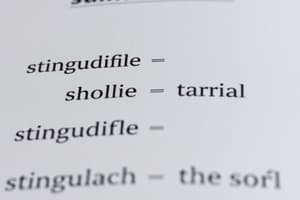Podcast
Questions and Answers
What is the primary goal of least-squares fitting in the context of data analysis?
What is the primary goal of least-squares fitting in the context of data analysis?
- To minimize the sum of the squares of the errors between observed and predicted values. (correct)
- To find the most complex polynomial that fits the data.
- To maximize the difference between the observed and predicted values.
- To minimize the sum of the y-values of the points.
Given the set of points (1, 1), (2, 1), (3, 2), how can you describe the trend observed?
Given the set of points (1, 1), (2, 1), (3, 2), how can you describe the trend observed?
- The points are randomly distributed without any trend.
- The points lie on a horizontal line.
- The points exhibit a slight increasing trend. (correct)
- The points form a vertical line.
When adding multiple instances of the point (3, 2) to the dataset, what effect does it have on the least-squares line?
When adding multiple instances of the point (3, 2) to the dataset, what effect does it have on the least-squares line?
- It has no effect on the least-squares line.
- It makes the least-squares line fit worse.
- It alters the slope of the least-squares line significantly.
- It will pull the least-squares line closer to (3, 2). (correct)
In the context of a line defined as $y = mx + b$, what does 'm' represent?
In the context of a line defined as $y = mx + b$, what does 'm' represent?
For which function template will the method of least squares NOT work due to nonlinearity?
For which function template will the method of least squares NOT work due to nonlinearity?
As $n$ approaches infinity in the given dataset, what is the expected behavior of $ ilde{m}$?
As $n$ approaches infinity in the given dataset, what is the expected behavior of $ ilde{m}$?
Which of the following statements about transition matrices is true?
Which of the following statements about transition matrices is true?
If a transition matrix T has an entry T(3,2), what does it represent in a population movement diagram?
If a transition matrix T has an entry T(3,2), what does it represent in a population movement diagram?
Which function is typically the simplest to fit to a set of data using least-squares?
Which function is typically the simplest to fit to a set of data using least-squares?
What is a common next step after determining the best-fit function using least-squares?
What is a common next step after determining the best-fit function using least-squares?
What is a characteristic of a regular transition matrix?
What is a characteristic of a regular transition matrix?
In the context of population movement, which statement about steady state vectors is NOT true?
In the context of population movement, which statement about steady state vectors is NOT true?
What might a reasonable estimate for the constant 'c' be when fitting $f(x) = a + bc$ for larger values of 'x'?
What might a reasonable estimate for the constant 'c' be when fitting $f(x) = a + bc$ for larger values of 'x'?
Which function template is capable of representing a periodic behavior in population transitions?
Which function template is capable of representing a periodic behavior in population transitions?
What implication does having a transition matrix where T^7 = I have on the population dynamics?
What implication does having a transition matrix where T^7 = I have on the population dynamics?
In context of least squares fitting, why might f(x) = a sin(bx) + c have issues?
In context of least squares fitting, why might f(x) = a sin(bx) + c have issues?
What matrix property is primarily utilized when computing the singular value decomposition of matrix A?
What matrix property is primarily utilized when computing the singular value decomposition of matrix A?
For the points (-1,3), (0, 1), (1,2), and (3,9), which form of polynomial is used to determine the best-fit curve?
For the points (-1,3), (0, 1), (1,2), and (3,9), which form of polynomial is used to determine the best-fit curve?
In the exercise involving the points (0,0), (0,1), and (1,1), what is a significant feature concerning the obtained least-squares lines?
In the exercise involving the points (0,0), (0,1), and (1,1), what is a significant feature concerning the obtained least-squares lines?
When estimating the orbit of an object in polar coordinates with given observations, which equation structure is used?
When estimating the orbit of an object in polar coordinates with given observations, which equation structure is used?
In least-squares fitting, how does repeating a data point affect the fitting process?
In least-squares fitting, how does repeating a data point affect the fitting process?
For the least-squares paraboloid determined from the points (-3,-2, 45), (2, -2, 30), (0,1,6), (-2, 3, 55), and (6,5,230), what form does it primarily take?
For the least-squares paraboloid determined from the points (-3,-2, 45), (2, -2, 30), (0,1,6), (-2, 3, 55), and (6,5,230), what form does it primarily take?
When estimating all $x$ such that $f(x) = 10$ for the determined least-squares parabola, which method is typically employed?
When estimating all $x$ such that $f(x) = 10$ for the determined least-squares parabola, which method is typically employed?
To check the results of the singular value decomposition, which alternative method can be employed?
To check the results of the singular value decomposition, which alternative method can be employed?
Flashcards are hidden until you start studying
Study Notes
Singular Value Decomposition
- Compute both AATAA^TAAT and ATAA^TAATA to find the singular value decomposition (SVD) of a matrix A.
- Calculate the eigenvalue/eigenvector pairs for both matrices.
- Determine the corresponding singular values.
- Combine the results to obtain the SVD.
- Verify the answer using technology.
Least-Squares Parabola
- Find the least-squares parabola f(x)=ax2+bx+cf(x) = ax^2 + bx + cf(x)=ax2+bx+c that best fits a set of given points.
- Plot the parabola along with the points.
- Use the parabola to estimate the x-values where f(x) equals a given value.
Least-Squares Paraboloid
- Find the least-squares paraboloid f(x,y)=ax2+by2f(x, y) = ax^2 + by^2f(x,y)=ax2+by2 that best fits a set of given points.
- Use the paraboloid to estimate the value of f(x, y) at a specific point.
Best-Fit Lines
- Find the least-squares best-fit line of the form y=mx+by = mx + by=mx+b and x=ny+cx = ny + cx=ny+c for a set of given points.
- The lines may not be the same, highlighting the impact of the chosen form on the fit.
- Plot the points and both lines to visualize the different best-fit lines.
Least-Squares Ellipse
- Find the least-squares best-fit ellipse of the form Ar2cos2θ+Br2sin2θ=1Ar^2 cos^2 θ + Br^2 sin2 θ = 1Ar2cos2θ+Br2sin2θ=1 from given observations of angle and distance.
- Use the ellipse to predict the distance at a given angle.
- Determine the maximum distance the object reaches from the origin.
Impact of Repeating Data Points
- Repeating data points increases the weight of the corresponding distance to the best-fit line in least-squares fitting.
- This results in a line closer to the repeated point than to other points.
- The weight of a point is determined by its number of repetitions.
Least-Squares Line with Repeated Points
- Consider a set of points with one point repeated n times.
- Write down the corresponding matrix equation for the least-squares line.
- Solve for m^\hat{m}m^ using the least-squares method to find the slope of the best-fit line.
- Find the limit of m^\hat{m}m^ as n approaches infinity, showing that the best-fit line converges to a specific slope.
- The best-fit line passes through the repeated point, illustrating the influence of repeated data points.
Data Modeling with Least-Squares
- Fit different functions (mx+bmx + bmx+b, ax2+bx+cax^2 + bx + cax2+bx+c, a+bca + bca+bc) to a set of data points using least-squares.
- Calculate the least-squares error for each function to determine the best fit.
- Use the best-fit function to predict the value at a specific point and find the x-values corresponding to a given y-value.
Finding Best-Fit Functions for Various Data Sets
- Plot given data sets to identify potential function forms, such as linear, exponential, or sinusoidal.
- Use least-squares to find the best-fit function for each data set.
- Estimate the y-value corresponding to a specific x-value based on the best-fit function.
Applicability of Least-Squares
- The method of least-squares is applicable to linear functions where the unknowns are coefficients of the independent variables.
- It is not directly applicable to non-linear functions.
- For example, a function like f(x)=eax+bxf(x) = e^{ax} + bxf(x)=eax+bx cannot be directly solved using least-squares due to the exponential term involving the unknown variable.
Regular Transition Matrix and Population Movement Diagram
- Draw the population movement diagram corresponding to a given transition matrix.
- Determine if the matrix is regular, meaning that there is a power of the matrix where all entries are positive.
- Justify the regularity based on the matrix structure and the diagram properties.
Transition Matrix and Long-Term Population Distribution
- Create a transition matrix T based on a given population movement diagram.
- Calculate specific entries of T and its powers based on relationships between states and transitions.
- Determine the minimum power k for which a specific entry of T^k is nonzero and calculate its value.
- Identify entries that are always zero for all powers of T.
- Intuitively explain the long-term population distribution based on transition probabilities and connections in the diagram.
Transition Matrix with Cyclic Behavior
- Find a transition matrix T with cyclic behavior, satisfying T^7 = I but T^k ≠ I for k < 7.
- This demonstrates that not all transition matrices exhibit limiting steady states.
Limiting Steady State Vector
- Find the limiting steady state vector for a transition matrix T based on a population movement diagram with parameters a, β, and transitions between states.
- Determine if a limiting steady state vector always exists for a transition matrix T.
- If a limiting steady state does not always exist, explore potential conditions for its existence.
Studying That Suits You
Use AI to generate personalized quizzes and flashcards to suit your learning preferences.




